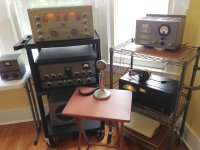RCA, the last American vacuum tube manufacturer, closed in the 80's due to being over regulated by the EPA. It became too costly to make a good product at a profit. The plant was located on Lester rd 2 1/2 miles from my home and a lot of locals had started and raised families thanks to RCA.
Even though solid state amps were cheaper, low maintenance and reliable, tube amps were beginning a comeback. Tubes were now coming out of Russia and China (we don't need no stinkin' EPA). Quality was quite good actually.
Tube heads are now in two camps: British and American.
The American 6L6, 6V6 and 6550 output tubes would hold their "glassy, shimmery" tone at volume. The Britsh EL34, EL84 and KT88 output tubes would "voltage sag" quicker to distort at lower volumes.
Pre-amp tubes, ecc83, 7025, 12ax7a, 12at7 etc. are tailored to "break up" differently depending how hard you drive the pick ups. Some a lot, others not at all.
It's like reloading: swap out certain tube values, the rectifier and re-bias it and you can make it do what you want.
Hint: if your amp has 4 output tubes pull the two on each end out and reduce it to half power and, for smaller venues, it will distort quicker.
Sorry to be so long winded but it is part of what I did and I don't get to talk shop much as guitar forums are much more adversarial than any gun forum.

